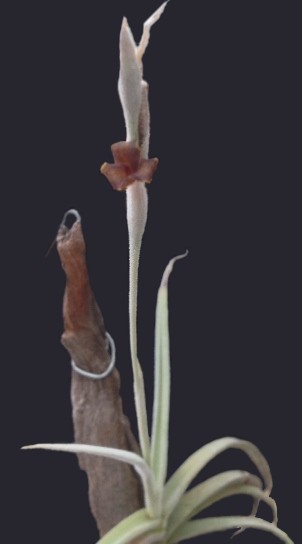
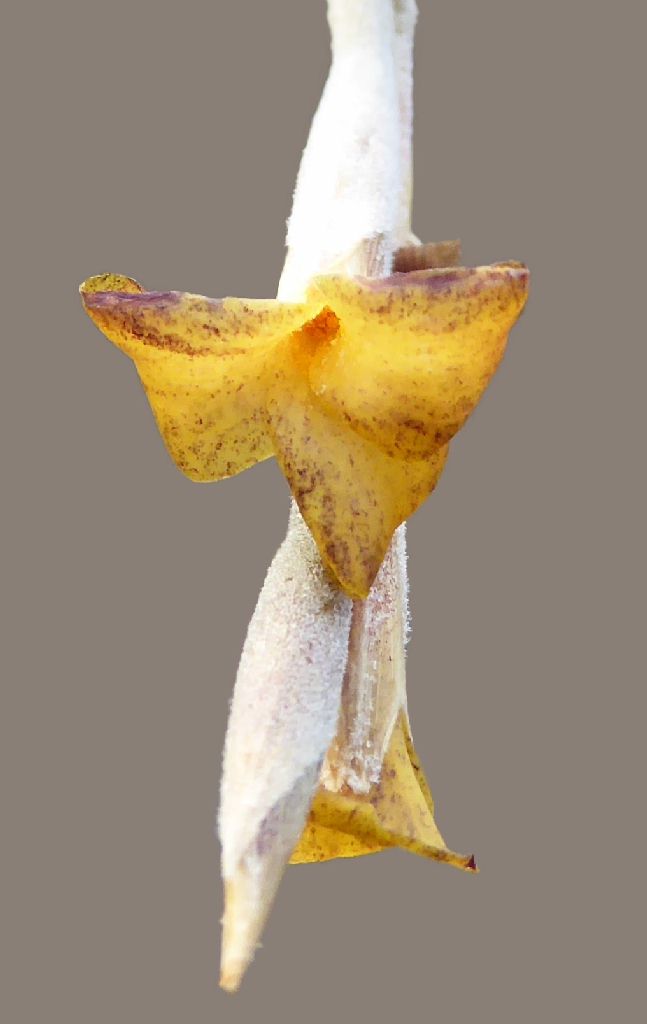
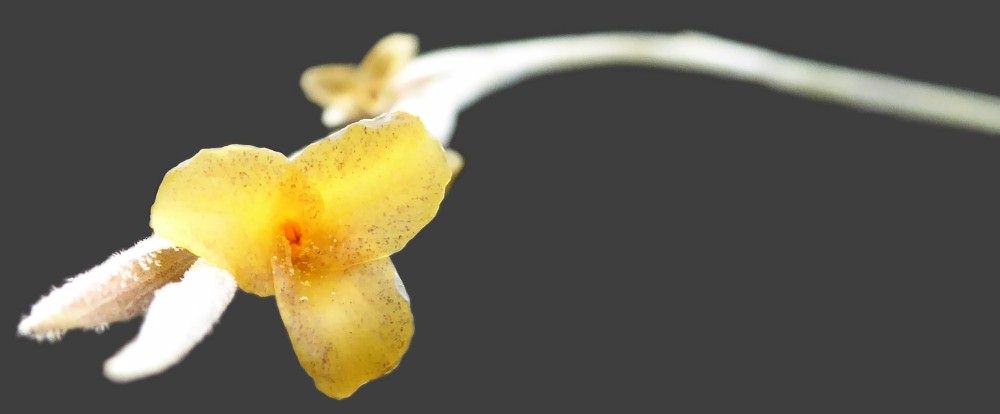
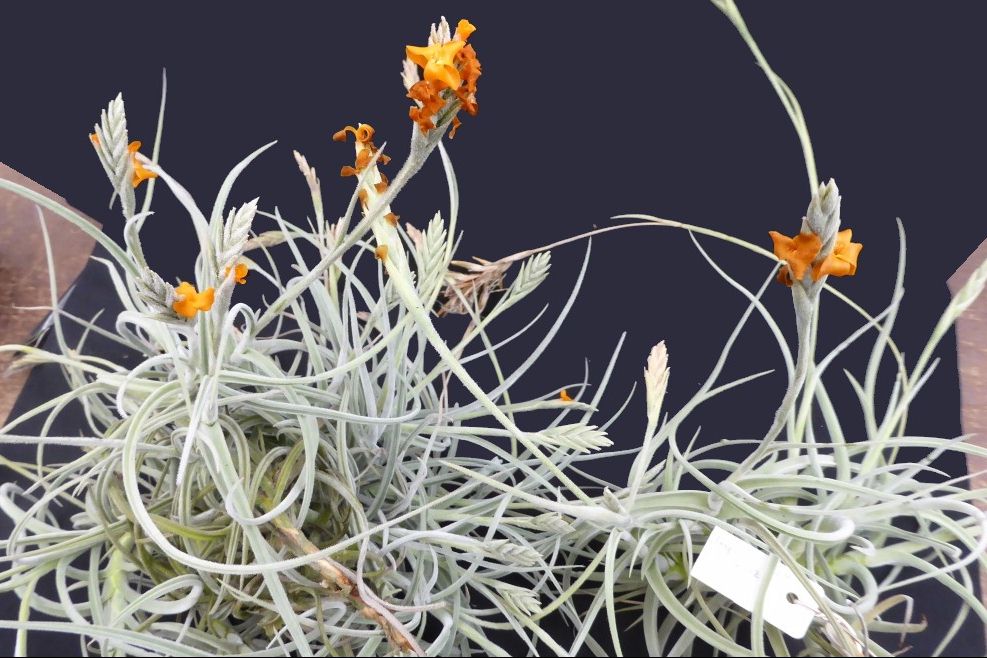
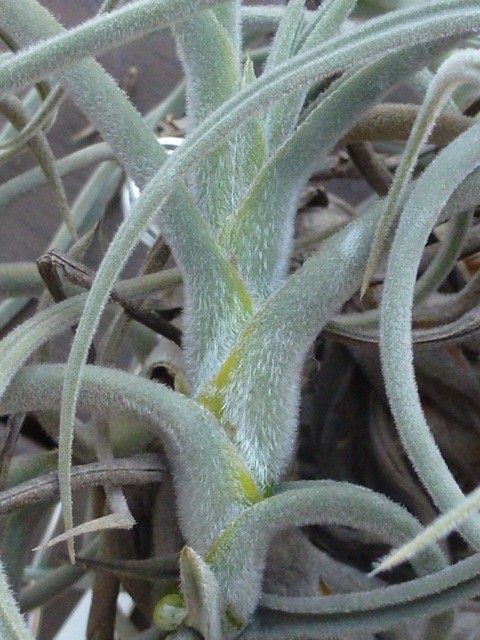
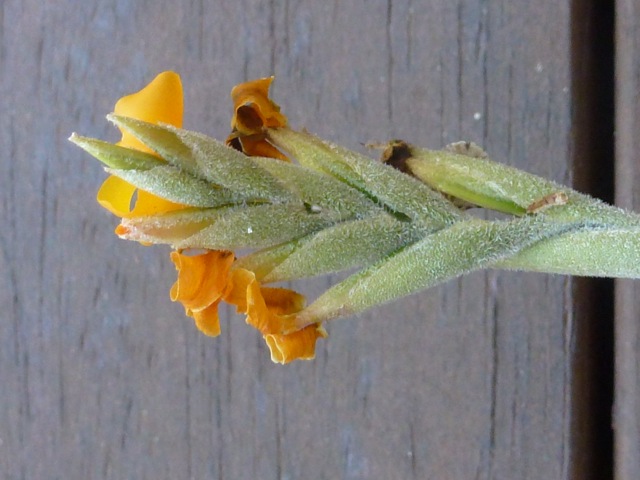
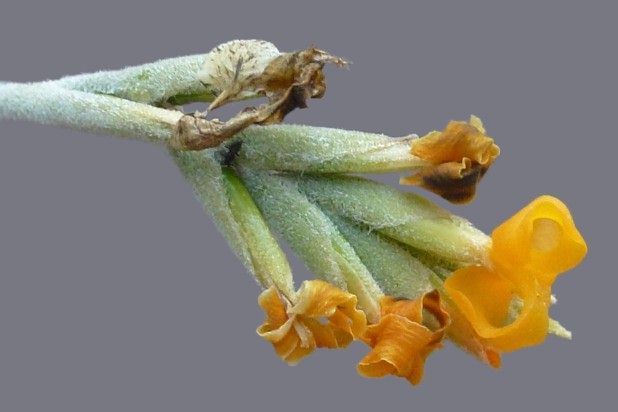
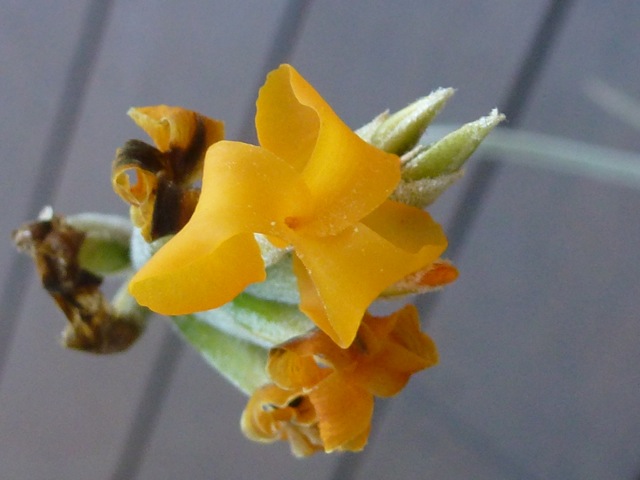
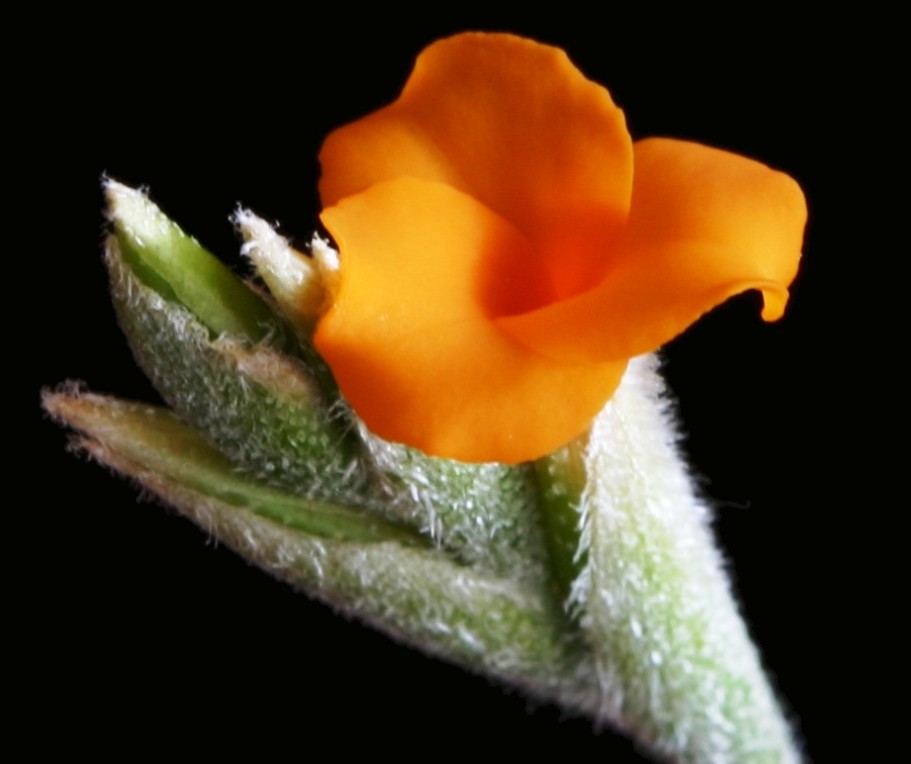
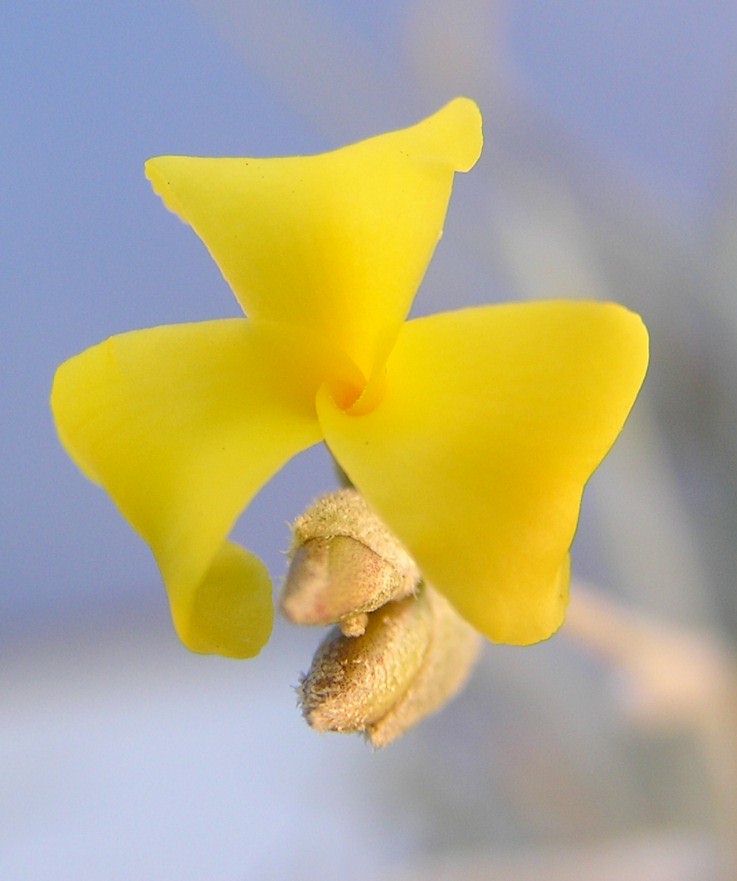
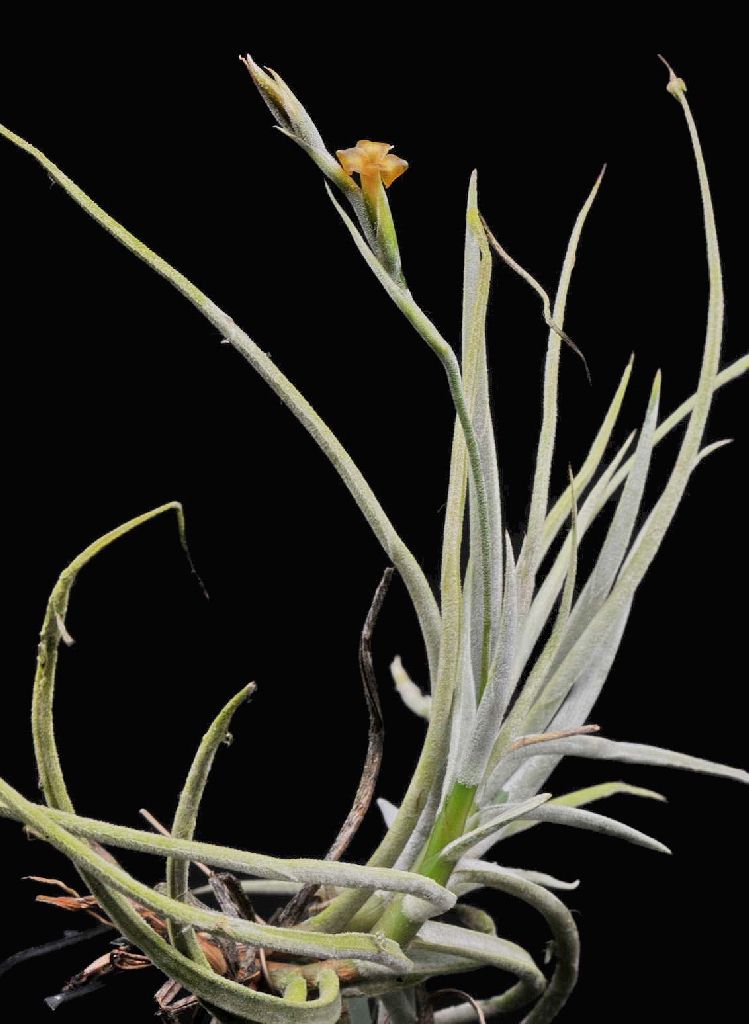
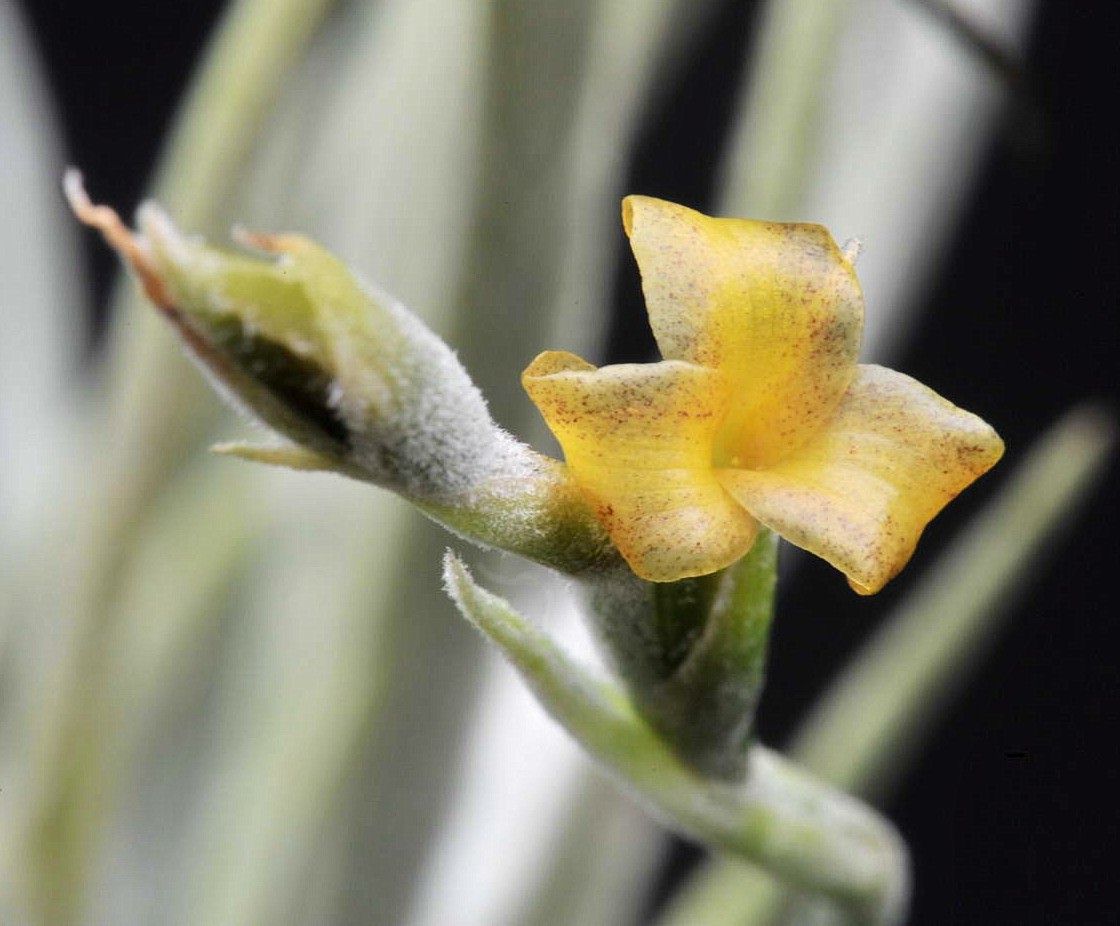
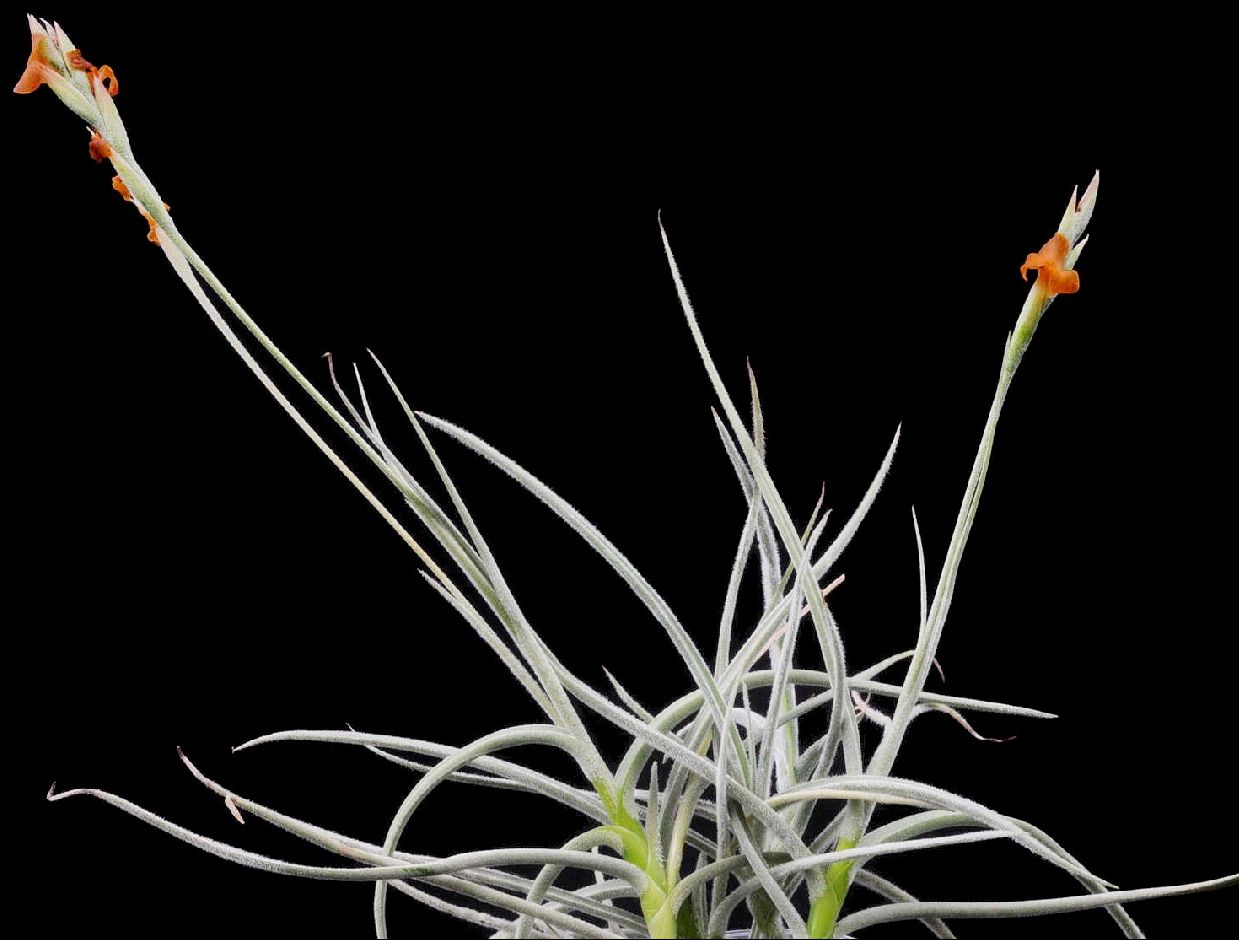
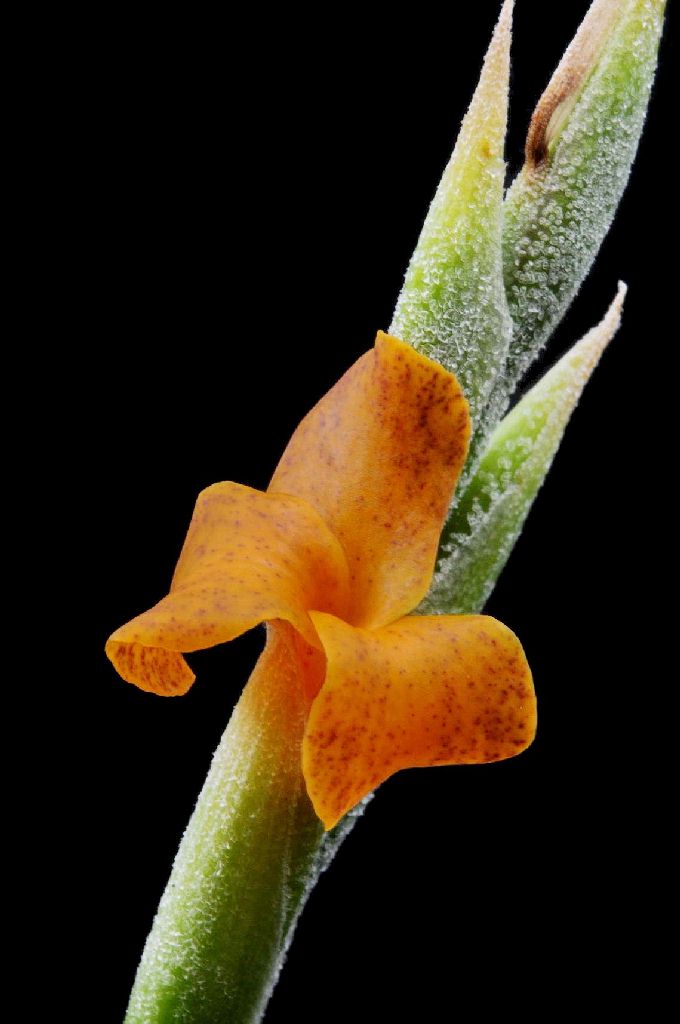
I have had great difficulty getting true colours in the flowers with my little camera. I’ve had to shoot in a variety of light – but these ones I have posted are very very close, if not exact. There are also other lovely distinct forms of caliginosa – one I have is nearly black. Another I collected in Argentina has exceptionally short leaves. I like them.
Bruce Dunstan 30/05/16 see pictures above.
Hi Chris: Nice informative post. I have wondered about a plant I had as Rutchman's Orange that I got from Peter Tristram years ago and sadly parted company with its label. Looking at the images on the BCR and the trichomes at the leaf bases I'm happy to relabel it as Rutchman's Orange.
Bruce Dunstan 31/05/15
Hi Derek: It will be flowering in a couple of months. I'll take some snaps and we can see then. It seems another larger growing clone though is slightly smaller than Rutchman's Orange. My T. crocata seems to be about half the size of Ruchman's Orange and the Buttercup is midway between the two, if that make sense. I'm hoping Peter Tristram may have some information on source etc. Buttercup on the left and Ruchman's Orange on the right.
Derek Butcher 31/05/2015
Bruce: I can understand the difference between yellow and orange but what Buttercup are you talking about - the Pommie one or the Aussie one? Seems tautology to me.
Bob Hudson 31.05/15
My 2 cents worth: I have 3 different forms of T. crocata 'Orange' they have slightly different shades of Orange and are different in looks.
Peter Tristram 02/06/2015
Hi all, after some crocatas from Holm bloomed buttercup yellow I used that name, assuming a mix of yellow, Ruchman's Orange or caliginosa. The ones from RFI vary and Paul told me they are the German orange x yellow, the grex named Copper Penny. They are large like Ruchman's Orange but can vary from yellow to orange, mostly the latter. T. caliginosa varies from pure light yellow to dark and most forms are spotted.
Derek Butcher 02/06/15
Peter: Where did you find it reported that T. caliginosa can have yellow petals? The very name suggests something muddy and there is also the German Nurseryman's name of T. diabolica to consider.
Playing at hybridising without reporting what has been done causes misconceptions and as Chris says, very few analyse seedling results these days. Thus I suspect a yellow flowering T. caliginosa is a hybrid.
What were the aims of the hybridist in crossing T. crocata forms to produce Copper Penny NN ? Perhaps attempts have been made to cross the green petalled form.
Much data is on the DVD on T. crocata and T. caliginosa but if you have authenticated published data I would be glad to add it.
Chris Larson 02/06/15
Hi Derek: See #2. T.caliginosa LH#5012. Collected at Tin Tin, Cochabamba, Bolivia. 2300m. The original post contained this plant. Seems yellow to me. Is there doubts on this label?
Also the very dark form (almost black) comes from a German collector that doesn’t grow hybrids to my knowledge. We’ll chase this one down when Peter gets back.
As per that old question of ‘what were they thinking’ when they did this cross: Much of the commercial crossing is to get volume with stronger growth - commonly referred to as hybrid vigor. Or even to get better success rate in germination. There is not only crossing for the look of the plant, but to breed certain growth characteristics into a plant (faster growth, wider climatic tolerances, etc). They might like the style/look of the plant, but want something that is more vigorous in their conditions.
Derek Butcher 02/06/15 see T. caliginosa description (below), T. crocata Varella1 and T. crocata CU3 pics
Chris: Is this the colour I am to expect with T. crocata. To me I see muddy overtones and Margaret says it has brown spotted edges. Perhaps someone with younger eyes can confirm. As I said, if there is anyone with proof that the detail on the DVD is incorrect I will seek clarification
Peter Tristram 15/06/15 see T. caliginosa, Y Tin Tin x2, T caliginosa Holm06PT x2 pics
Hi Chris, Eric: As far as I know the dark form of caliginosa came from the Fischer collection which was distributed before and during the 2011 Berlin meeting. You came to Berlin with Peter B, Eric.
Attached are a couple of forms of caliginosa, one from Holm when I visited him with Eric in 2006 and the other from Lotte in 2012 which would be the yellow Tin Tin form.
Dale Dixon 8/12/20 ... "Recently I purchased a T. caliginosa (WT10092) from Ray Clark ex DB. Ray didn’t have the collection details. I couldn’t find the details on the Vienna Herbarium virtual herbarium so I write directly to Walter Till. He provided the following collection details:
"WT 10092 is from Argentina, Prov. Jujuy, Depto. Volcán, 1 km north of Tumbaya along the ruta 9 to Humahuaca, 2040 m asl., 8 Feb 1993, epiphytic on columnar Trichocereus." ."
Tillandsia caliginosa W.Till. Pl. Syst. Evol. :147. 282 (1984)
Syn. : T. myosura GRISEBACH, Symb. Fl. Argent. 333, 1879, p. p., non BAKER 1878. – T. myosura sensu LORENTZ & NIEDERLEIN, Roca Exped. Rio Negro 2: 281, 1881, non BAKER 1878. – T. crocata (E. MORREN) BAKER var. tristis RAUH, Trop. Subtrop. Pflanzenw. (Akad. Wiss. Lit. Mainz) 43: 17,1983 (incl. f. major RAUH nom. nud., l.c.: 18).
Desc from Rauh’s T. crocata v. tristis with amendments.
Plant- short stemmed, flowering to 20 to 40 cm high; stem simple or branched ± 8 cm long, 0.5 cm thick.
Leaf- ± 10, distichous.
Leaf sheath- to 2 cm long, 2.4 cm wide, lively green, strongly nerved naked.
Leaf blade- horizontal spreading to reflexed, 12 to 18 cm long, lineal subulate, long attenuate, (flexuous – Butcher!), rolled inwards, 2 to 5 mm thick, dense grey lepidote, scales eccentric.
Floral stem- very thin, 10 to 15 cm long, straight or abundantly geniculate, dense grey lepidote.
Scape bract- 0 – 2 , leaflike.
Inflorescence- always simple, laxly distichous, to 6 cm long and 0.5 to 1 cm wide, 2 to 4 flowered, strongly lepidote, flat, erect or flexuous rhachis visible.
Flower- short stemmed erect.(scented Till!)
Flower bracts- erect ± 1.5 to 2 cm long, as long as or shorter than the sepal, not keeled, almost enveloping the base of the rhachis, brownish-green, dense grey lepidote.
Sepal- both posterior ones keeled and joined for a short way, dense grey lepidote.
Petal- very small, with smooth wide 2 x 2 mm, dark, almost blackish brown or with 1 (-1.5) cm long and 4 mm wide rolled back tip, dark brown platten which has a dirty yellow mid-stripe.
Stamen & Style- deeply enclosed.
Holotypus: Argentinia, Prov. Jujuy, leg. D. MUHR S. n., HEID 30925 (HElD).
Paratypi: Bolivia: Cochabamba, Vinto, 2530msm., 11.6.1957, leg. A. JIMENEZ 22 (US); Tarija, Cotagaita, Bresadolia, 2600msm., 14.5.1927, leg. C. TROLL 3369 (B); Tarija, San Augustin, 10.6. 1873, leg. P. LORENTZ & G. HIERONYMUS 969 (GOET, NY); Argentina: Jujuy, Huacalera, 2650msm., 5. 2.1959, leg.A. CABRERA & H. FABRIS 13244 (US); Tucuman, Tafi, Quebrada de Amaicha, 2000 msm., Dec. 1931, R. SCHREITER 7663 (NY).
Distribution- Widespread in northern-most Argentina and Bolivia while T. myosura is distributed much further south in the more arid areas of Argentina.
Detail from Till & Hromadnik in Pl. Syst. Evol. :147. 284 (1984)
T. caliginosa has been known for a long time to be a distinct species (See Studies in Bromeliaceae by Lyman Smith VI p200-1. 1935 under T. myosura) It bears a relationship with T. myosura Grisebach ex Baker in the wide sense. Baker based the description on two collections.
1. Mandon 1180 subsequently separated (Mez 1896) to T. mandonii E Morren ex Mez in DC
2. Lorentz 122 the type for T. myosura Grisebach ex Baker (Smith & Downs 1977)
A year after Baker published, Grisebach did likewise for T. myosura (Grisebach1879). Lorentz and Niederlein in 1881 found that Lorentz 122 and, Lorentz & Hieronymus 969 had erroneously been linked by Grisebach and proceeded to correct the matter! Lorentz 122 became T. nappii. Lorentz and Hieronymus 969 remained as T. myosura Gr.. Smith & Downs (1977) treated T. nappii as a synonym of T. myosura Gr. and this still stands.
{This leaves us with Mandon 1180 which was treated as a synonym of T. crocata in S&D (1977) but resurrected here as a species in its own right, AND Lorentz & Hieronymus 969 which is included as a Paratype of T. caliginosa see above!}
Now let us consider the publishing by Rauh of a variety of a plant with southern Brazil habitat of T. crocata (E Morren) Baker. We believe that basically there is sufficient morphological difference between the type and the variety tristis for it to be considered separately, and is treated as a synonym of T. caliginosa. Let us remember that Mez (1896) described a T. tristis (Now R. Riocreuxii) so this cannot be used in this case.
T. caliginosa is in Bolivia and the borders of northern Argentina and has a very uniform habit, only in the area of Tarija (Dept Tarija, Bolivia) is there a strong tomentose form. In the Argentinian Province of Salta (South of Alemania- HR7185) grows a population with striking large flowers, but in proportion not deviating from the type. In habit they are like the populations in Bolivia.
Walter Till comment 4/3/ 1994
In T. caliginosa the petals are usually dark brown (hence the name) or if brownish-yellow then spotted, flower fragrance is rather strong and perfume like. The leaves are nearly exactly distichous, rather soft, and their sheaths usually strikingly glabrous. The inflorescence axis is usually nearly straight with rather long internodes. The plant is widespread in northernmost Argentina and Bolivia while T. myosura is distributed much further south in the more arid areas of Argentina.
Tillandsia crocata (E. Morren) Baker by W Rauh in Trop Subtrop Pflanz 43: 15-19. 1983
In the past few years through the collectings of Mrs. D. Muhr, Argentina and H. Hromradnik, Austria, remarkable T. crocata - forms have become known, and the knowledge of the inflorescence, flowering and petal colour deviates so strongly from the T. crocata noted up to now, that these must be treated as separate varieties. Therefore, we have var. crocata and var. tristis described as a new variety.
Tillandsia crocata (E. Morren), Baker, Journ. Bot. London 25, 214, 1887
Type: Lietze s. n. Rio de Janeiro, Brazil, 1879. , However none of the existing plants at that time would have been made the Type by Morren.
var. crocata
Inflorescence simple, complanate, lanceolate to elliptical, acuminate, 1 - to 6-flowered spike; floral bract ± imbricate; Petal to 2 cm long, 6-8 mm wide (fig. 8), shiny yellow, more rarely dark-orange-coloured or green.
Range: on rocks, between 875 and 2650 m high, from Bolivia to South Brazil, Argentina and Paraguay.
var. tristis Rauh var. nov.
Plantae solitariae breviter caulescentes, florens 20-40 cm altae; caulis simplex vel ramosus, plus minusve 8 cm longus, 0,5 cm diametiens. Folia plus minusve 10, disticha. Vagina usque ad 2 cm longa, 1,4 cm lata, laete viridis, valde nervata glabra. Laminae rectangulariter patentes vel recurvatae, usque ad 12-18 cm longae, lineali-subulatae, longe attenuatae, involutae, 2-5 mm diametientes, dense cano-lepidotae; lepides excentricae; scapus inflorescentiae tenuissimus, 10-15 cm longus rectus vel saepe geniculatus, dense cano-lepidotus; phyllis scapi 0-2 subfoliatis. Inflorescentia semper simplex laxe disticha, usque ad 6 cm longa, 0,5-1 cm lata, 3-vel 4-flora, axis valde lepidotus applanatus erectus vel flexuosus. Bracteae florales erectae, plus minusve 1,5-2 cm latae tam longae vel breviores quam sepala, ecarinatae basibus rhachim amplectentes glaucae, dense cano-lepidotae. Flores breviter pedunculati erecti. Sepala posteriora carinata breviter connata dense cano-lepidota. Petala minutissima explanata 2 x 2 mm metientia fere atrobrunnea 1 (-1,5) cm longa, 4 mm lata apicibus revoluta atrobrunnea tum stria media lurido-lutea. Stamina cum stylo profunde inclusa.
Single plant with short stem, flowering 20-40 cm high; small stems simple or branched, ± 8 cm long, 0,5 cm thick;
Leaves ± 10, distichous, (fig. 9, left).
Sheath to 2 cm long and 2,4 cm wide, lively green, strongly nerved, glabrous.
Blades horizontal spreading to bent over, 12-18 cm long, linear-subulate, long attenuate, involute, 2-5 mm thick, densely grey lepidote, (fig. 9, left); scales eccentric.
Scape very thin, 10-15 cm long, straight or clearly geniculate, dense grey lepidote, with 0-2 subfoliate scape bracts.
Inflorescence always simple, laxly distichous, (fig. 9, right), to 6 cm long and 0,5-1 cm wide, 2 - to 4-flowers, strongly lepidote, complanate, erect or flexuous axis visible.
Floral bracts erect, ± 1.5-2 cm long, as long as or shorter than the sepals, ecarinate, enclosing the rhachis at the base, brownish green, dense grey lepidote.
Pedicel short, erect.
Sepals, the posterior pair carinate and short connate, dense grey lepidote.
Petals very small, with flat extended, 2 x 2 mm large, dark -, almost black brown or to 1 – 1.5 cm long and 4 mm wide at the rolled over tips, dark brown platte, with dirty yellow mid line.
Stamens and Style deeply enclosed.
var. tristis f. tristis
Flowers insignificant, platte only 2 x 2 mm large, uniformly dark, (fig. 9).
Flowers opening only in the morning.
Type: D. MUHR T1/8B = B.G.H. 46 737
Habitat and Range: without exact location, El Aquilar, Prov. Juju, Argentina.
var. tristis f. major Rauh
Plant larger in all parts. Platte of the petals dark brown with dirty yellow midline, 1,5 cm long, 4 mm wide, wide with bent over, blunt tips (fig.10);
Flowers open for several days.
Type: B.G.H. T. 1.269, leg. D. Muhr, Argentina s.n.
Habitat and range: without more exact location, El Aquilar, Prov. Juju, Argentina.
Both forms of var. tristis in HEID., The small-flowered form, (f. tristis) is from the Cactus firm SPI (Sudpflanzenimport, Wiesbaden) being traded under the invalid name T. diabolica.
Also the var. crocata is quite variable regarding size of spike, number of flowers and flower colour. The following deviant forms are cultivated in the botanical garden of the University Heidelberg:
Rauh 48 801: dwarf-form, flowering only to 10 cm high. Inflorescence 1-flowered {Vila Velha, Brazil; fig. 8, right, (left plant)}.
Dr. Rutschmann, Basel; B.G.H. No. T1.204: very large form with 6 - to 7-flowered inflorescence and fragrant, dark-orange-coloured flowers (Brazil) without location; (fig. 8, right).
Dr. Hromadnik, Kritzendorf, Austria 5048 (= B.G.H. 50 975,: flowers green, Bolivia, Tarija.
However, the differences lie within the variations of var. crocata, so it is not necessary to describe them as separate varieties.